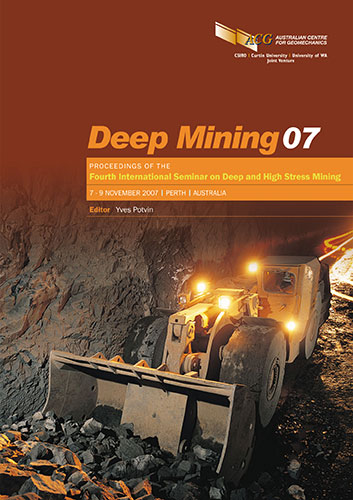Planning and Practice of Remnant Pillar Mining - A Case Study

|
Authors: Wienand, GA; Ferreira, RIL |
DOI https://doi.org/10.36487/ACG_repo/711_11
Cite As:
Wienand, GA & Ferreira, RIL 2007, 'Planning and Practice of Remnant Pillar Mining - A Case Study', in Y Potvin (ed.), Deep Mining 2007: Proceedings of the Fourth International Seminar on Deep and High Stress Mining, Australian Centre for Geomechanics, Perth, pp. 141-162, https://doi.org/10.36487/ACG_repo/711_11
Abstract:
The extension of the life of some shafts by mining extractable, accessible and economically viable remnant pillars, has become much of a necessity. The geotechnical investigation into the potential for successful extraction of these pillars is crucial, and is approached in a multi-disciplinary manner. This case study outlines the mining methodology, and relates the initial investigation to the practical experience of extracting a 8000 m2 remnant pillar in a tabular reef at 1600 m depth, at the Thabelang “Let’s be happy” Shaft of Gold Fields’ Driefontein mine.
References:
Code of Practice to Reduce Rockfall and Rockburst Accidents, Driefontein Gold Mine.
Driefontein Gold Mine Standard (2003) Std_RE1. Guidelines for the Rock Engineering Investigations for Pillar Mining.
Jager, A.J. and Ryder J.A. (1999) (eds) A Handbook on Rock Engineering Practice for Tabular Hard Rock Mines. The Safety in Mines Research Advisory Committee (SIMRAC), Johannesburg, pp. 25-26, p. 30, pp. 33-34.
Van Aswegen, G. (2005). Routine seismic hazard assessment in some South African Mines. 6th International Symposium Rockbursts and Seismicity in Mines, RaSiM6, Y. Potvin and M. Hudyma (eds) Australian Centre for Geomechanics, Perth, Australia.
© Copyright 2025, Australian Centre for Geomechanics (ACG), The University of Western Australia. All rights reserved.
View copyright/legal information
Please direct any queries or error reports to repository-acg@uwa.edu.au
View copyright/legal information
Please direct any queries or error reports to repository-acg@uwa.edu.au